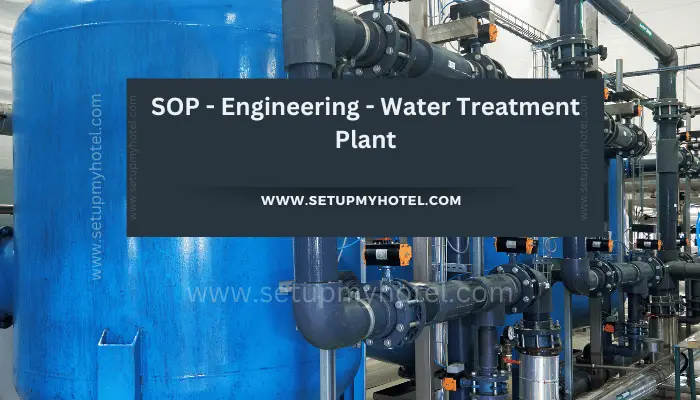Standard Operating Procedure for Engineering Water Treatment Plant
Water Treatment Plant Operation Standard Procedure:
A Standard Operating Procedure (SOP) for engineering in a water treatment plant is a crucial document that outlines the step-by-step process for ensuring clean, safe water for consumption.
The SOP for engineering at a water treatment plant would typically involve the following steps:
- Source Water Intake – This is the first step in the water treatment process where the water is collected from a water source, such as a river or a reservoir.
- Screening – The water is then passed through a series of screens to remove large debris such as sticks, leaves and other solid materials.
- Chemical Treatment – In this step, chemicals such as chlorine are added to the water to kill bacteria and other harmful microorganisms.
- CoagulationCoagulation - The process of becoming thick or solidifying. The kitchen; it usually refers to the fi... and Flocculation – Coagulants such as alum are added to the water to remove suspended solids and other impurities.
- Sedimentation – The water is then allowed to settle in a tank where sediment and suspended solids sink to the bottom.
- Filtration – The water is passed through a series of filters to remove any remaining impurities.
- DisinfectionDisinfection is a condition existing when infectious material or infection(s) are removed. – Finally, the water is disinfected again with chemicals such as chlorine to ensure that it is safe for consumption.
- Overall, the SOP for engineering at a water treatment plant is vital for ensuring that the water supply is clean and safe for communities to use. It helps guarantee that all the steps in the process are followed consistently and accurately, ensuring that the water is treated effectively and efficiently.
The Water Treatment Plant consists of the following:
1) Raw water filters.
- It is used to remove the particular impurities or the suspended impurities from the untreated (hard water) i.e. raw water.
- The raw water filter requires backwash process to maintain efficient flow of water. With required quantity and pressure.
2) Water Softener Plant.
- Water softner plant is used to reduce the temporary hardness in the water.
- The soft water is being used at many places as it helps to avoid any damages to equipment used in the hotel like boilers and also other equipment where hot/cold water is regularly used.
- The softener used in the Hotels is a cation base.
- A chemical change takes place and softens the water by removing calcium and magnesium salts, which creates the temporary hardness of the water.
- It is a cold process basically known as Ion Exchange.
- The softener requires regeneration time to time to have a good quality of soft water throughout the system.
- Before doing regeneration, ensure that the raw water and domestic water tanks are also full.
- When the water hardness exceeds 80 ppm. Engineering team should perform the regeneration of softener.
3) Activated Carbon Filter.
- Activated carbon filters are generally employed in the process of removing organic compounds and/or extracting free chlorine from water, thereby making the water suitable for discharge.
- Eliminating organics in potable water, such as humic and fulvic acid.
- Prevents chlorine in the water from chemically reacting with the acids and forming trihalomethanes, a class of known carcinogens.
4) Hydropneumatic System.
- The Hydropneumatic System is a modernization of the older gravity tank method of water supply, Its main purpose is to control or boost a limited supply pressure to a higher or to a more uniform value.
- A hydropneumatic tank contains pressurized air and water.
- It does not have a bladder and air is in direct contact with the water.
- The compressed air acts as a cushion exerting or absorbing pressure.
- As the flow begins, one of the pumps starts at low speed and as the demand increases the pump speeds up until it reaches the full RPM level
- At this point, the second pump becomes operational (start).
- The speed of the two pumps varies till they reach the full RPM.At this stage, the next pump starts.
- The same sequence is repeated for the additional pumps and each pump, in turn, changes over automatically and maintains the system pressure according to the demand, time and fault.
- When the water demand is zero the system shuts-off automatically and when the system is running continuously, the lead pump alternates based on the time set.
Back WashWash - 1) Brushing or coating a food item with a liquid such as egg white; milk or egg wash. 2) The ... Procedure:
- It is the reverse process of normal supply through the filter.
- Backwashing of the filter required when the filter bed gets chock by determining the water pressure falling across the filter inlet and outlet.
- It should not exceed 5 psi in the bed by installed pressure gauges.
- In the normal course, the water enters the top of the filter bed and comes out from the bottom of the filter bed.
Training Summary questions:
Q1. What all consists of a water treatment plant?
Q2. Explain the sequence of backwash procedure?
Q3. What is a Hydropneumatic System?
Q4. Explain the functionality of activated carbon filter?
Q5. When to do a regeneration of the filters?
Patreon Only SOP Download
SOP Number: Hotel Engineering SOP – 04 Department: Engineering and Maintenance Date Issued: 13–Feb-2018 Time to Train: 30 Minutes












